Maternity & Childbirth
Analysis Categories
The rates of birth by age and select race/ethnicity, specific teen pregnancy rates, early prenatal care by age and select race/ethnicity, and rates of non-smoking among pregnant women by age and select race/ethnicity. Banded in 3 year increments since 2002 for Erie County.
Pregnancy and birth rates are another indicator of a community's growth in human capital. Concerning teen pregnancy, it can derail a young woman's life, preventing her from furthering her education or growing up to be self-sufficient. Babies born to teen mothers are at higher risk of having a low birth weight and of infant mortality compared to babies born to older mothers. They are also at risk of lower cognitive development, poor educational outcomes and living in poverty. Smoking during pregnancy can cause premature births or low birth weight, which presents an increased risk for illness and prolonged medical treatment. Smoking during pregnancy also is a risk factor for sudden infant death syndrome. Early, high-quality prenatal care is critical to reducing risks for complications of pregnancy or birth and improving birth outcomes.
Birth Rates
Birth rates show a natural bell curve among women from teenage to 45+ in Erie county, with the highest number of births occurring to mothers who are between 25 to 29 years of age. By race/ethnicity, White mothers represent 70.2% of all pregnancies, and while the percentage of mothers from other racial backgrounds (Asian Pacific Islander, Black, Hispanic, and Multiracial) is 29.8%.
Teen Pregnancy
Teen pregnancy has shown decline since the year 2006-to-2008, falling from 12.1% to 5.3% of all births within the County. Teen pregnancy remains highest amongst White Erie County residents across all analyzed age ranges.
Smoking During Pregnancy
Specifically looking at mothers smoking during pregnancy, Multi-Race and White women are more likely to be smokers at a rate of 31.8% and 13.5% respectively, compared to Asian (0.3%), Black (10.4%), Hispanic (10.6%) mothers. Smoking during pregnancy has fallen from 2006-2008, from 28.3% to 13.3% by 2020-2022. Despite this, Erie County's mothers are still more likely on average to smoke during pregnancy, compared to the PA state rate of 7.4%.
Prenatal Care
Early prenatal care rates are highest among White and Asian/Pacisifc Islander women (80% and 78% respectively), and for all women highest in age category 30 to 34 years and 20 to 24 years with 80%. Overall early prenatal care is higher among ages a15 to 44 years. Prenatal care rates dipped in 2006 to 2008, and while they've rebounded to 82.7% of all reported pregnancies, they've still not recaptured 2000 to 2002 rates which peaked at 83.4%.
Infant Mortality
Infant deaths are measured in crude rates per 1,000 live births. The infant mortality rate was highest during the period from 2006 to 2008, at 9.4%. This rate gradually decreased over the following years, reaching 6.5% between 2018 and 2020. However, in the most recent years, from 2020 to 2022, the rate has increased to 8.2%. When examining the data by race, there continues to be a significant disparity. The infant mortality rate for the Black population remains substantially higher compared to the White population, year after year.
EVS analyzes the data in each topic category using indicators, which report a targeted and digestible number, rate, or amount to represent Erie County as a whole. While this does not cover every aspect of the topic, it assists in establishing Erie's performance relative to the prior year(s). The indicators for the Health: Maternity & Childbirth topic are:
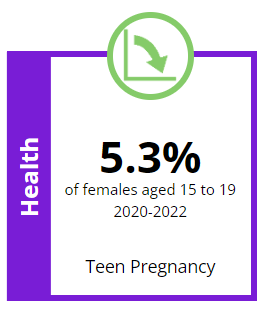
This indicator measures the share of girls ages 15 to 19 in a geographic area who have given birth in a given data years period. The trend for Teen Pregnancy was down and better for the latest 2020-2022 period with a reported decrease of -0.8% within the County. There were 501 teen births in the 2018 to 2020 period, as compared to 423 teen briths from 2020 to 2022.
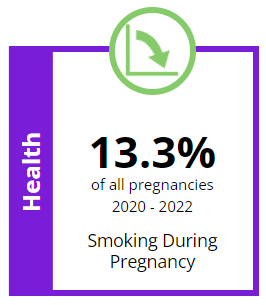
This indicator measures the share of births in a year to women of all ages who reported smoking during pregnancy. The trend for Smoking During Pregnancy was down and better for the latest 2020 to 2022 period with a reported decrease of -2.6% within the County. There were a total of 1,062 mothers who reported smoking during pregnancy.
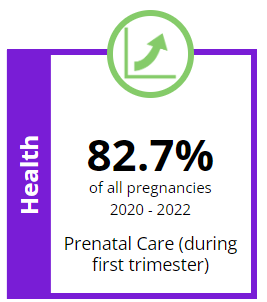
This indicator measures the share of mothers of all ages who reported receiving prenatal care during their first trimester. The trend for Early Prenatal Care was up and better for the latest 2020 to 2022 period with a reported increase of +1.8% within the County. There were a total of 1,370 mothers who reported not receiving early prenatal care during pregnancy.
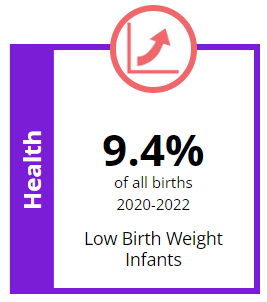
This indicator measures the percentage of low birth weight infants (babies who are born weighing less than 2,500 grams or 5 pounds, 8 ounces). The trend for Low Birth Weight Infants was up and worse for the latest 2020 to 2022 period with a reported increase of +0.2% within the County. There were a total of 753 low birth weight infants reported.
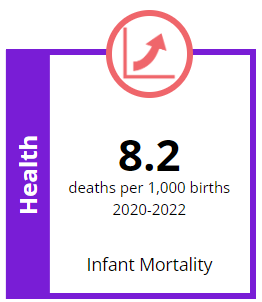
This indicator measures the number of deaths per 1,000 births per year for infants under the age of one year. The trend for Infant Mortality was up and worse for the latest 2020 to 2022 period with a reported increase of +1.7% within the County. There were a total of 66 infant deaths reported.
Data from the PA Department of Health as of 08/2024.

